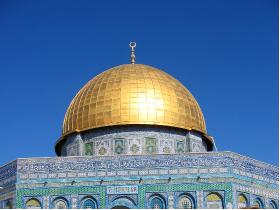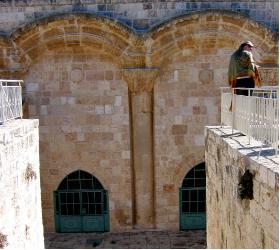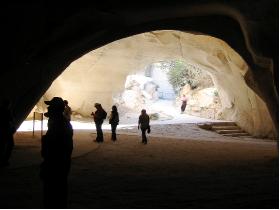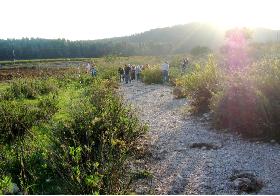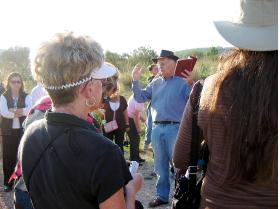 |
|
Israel Journal COLLEEN TINKER |
||||
NUMBER 14 — SUNDAY, NOVEMBER 9, 2008
Temple Mount, Bell caves, Valley of Elah, and the last ascent up to Jerusalem
The Temple Mount
Our day today began with a scheduled visit to The Temple Mount. This visit was “iffy”—sometimes our guides (who are really intrepid women and seem to have connections with people and are not shy about insisting on what’s possible) are not able to get their groups inside. People waiting in line to go in sometimes have to wait an hour-and-a-half before entering. We got there early today, though, and we got in relatively quickly—probably within a half-hour.
The temple mount is huge. I had not imagined it to be so spacious. According to the large model of Jerusalem that we saw yesterday at the museum, however, the temple and the outer courtyard surrounded by Solomon’s colonnade dominated the city. When we entered through the surrounding gates, I saw why.
Of course, the temple mount does not display the temple. Instead, the gold-domed Dome Of the Rock dominates the spot where the Holy of Holies used to rest. Opposite the Dome of the Rock but still within the precincts of the temple mount is the Al Aqsa Mosque where Muslims meet to pray. Underneath the Dome is, many scholars believe, the stone where Abraham offered Isaac. That deeply symbolic event prefigured God giving His own Son, and the substitute ram prefigured Jesus’ substitutionary death for our sin. Also, the Ark of the Covenant used to sit inside the Holy of Holies right on top of that same rock: Mt. Moriah.
We walked to the Eastern Gate, the gate through which the prophecies say the Messiah will come into the city. The Muslims, who dominate the Temple Mount, centuries ago filled in the entire gate area. They reasoned that by closing off the gate prophesied to be the entrance site of the coming Messiah, they could prevent any potential “messiah” from staging an entrance into the city.
Interestingly, in all the years our guides have led tours onto the Temple Mount, neither of them had ever been allowed to walk to the Eastern Gate. Guards had always prevented them from approaching the area. Today, however, we were not stopped from walking right up to the wall surrounding the gates, from walking around them, and even from taking pictures of each other with the gates behind us.
The temple mount is a beautiful area, but it is deeply upsetting to see that Muslim shrine perched on the place where God systematically revealed Himself through the centuries. God, however, will accomplish His own purposes in His own time. The Bible prophesies that the Lord Jesus will return, and no shrines or cemented gates will prevent His appearing at exactly the hour He has preordained.
After our time on the Temple Mount, we visited the Burned House Museum. This museum is in the Jewish Quarter of the Old City of Jerusalem. It is a moving movie presentation of the destruction of Jerusalem in AD 70 from the perspective of a Levitical family whose burned house had been excavated from that very spot.
Interestingly, whenever buildings in the Jewish Quarter or other areas of the city where the Jews have ownership are burned or destroyed, they excavate and do research before rebuilding. Over the past several decades, archeologists have found enough to give them a very accurate view of the development of the city through the eras of occupation it has seen.
Bell Caves and the Valley of Elah
After lunch, our group split into two groups. One group was comprised of those who elected to visit the Holocaust Museum in Jerusalem. The other group consisted of those who chose to visit another area of Israel that we would otherwise not see.
Richard and I were in the Valley of Elah group. (We decided that since we have access to the Museum of Tolerance in Los Angeles, we would visit the area we could not see at home.) The Valley of Elah is where young David killed Goliath. It is halfway between Jerusalem and the Gaza Strip—and the area is absolutely lovely. There is more vegetation—lots of pines and other drought-tolerant trees. The landscape is blanketed with crops dominant among which are vineyards.
Before we reached Elah we visited a national park where there are amazing bell-shaped caves in the chalkstone which are believed to have been Byzantine quarries. The caves are beautiful; various shades of red and brown wash their walls which adjoin each other through wide “doorways” leading from cave to cave. It is suspected that an early Byzantine church met in them since there are carvings of crosses and rosettes over and near some of the “rooms”. The walls of the caves arched into roofs as high as cathedrals. Before we left we sang “How Great Is Our God” and “How Great Thou Art”. The reverberation was several seconds—as good as any perfectly designed cathedral!
The Valley of Elah was a gem—and one that people usually miss. (Our guide told us that tours seldom request a trip to Elah.) It is completely unspoiled; no church or fence marks it or limits access. It has not been made into a shrine; it is just “there”, natural and pristine and beautiful. This is without any doubt the site of David’s confrontation with Goliath. The Philistines and Israelites gathered on opposing hills on the sides of the wide, flat Elah Valley. The brook that runs through the valley was dry today—it is a seasonal stream—but the creek bed was clearly visible. Like David, we walked along the creek and selected our own smooth stones. For us, the stones are souvenirs for us, for our children, and for our grandchildren. For David, they were ammunition.
We were at the valley about an hour before sundown. The sun was low and golden; the valley very green. Along the creek bed were pungent wild anise plants, and the people in our group were relaxed and carefree, kicking back and relaxing during this reprieve from our wonderful but tiring schedule of sightseeing. Several in our group including our pastor Gary gave some impressive demonstrations with a couple of slingshots someone had brought.
Last ascent into Jerusalem
At last we re-boarded the bus for our return to our hotel. As we approached Jerusalem and began what our guide called our “last ascent into Jerusalem”, she had the driver play the song “The Holy City” from a CD of Israeli music she had brought. The sun was setting, and the warm pink light colored the countless limestone buildings that comprise Jerusalem—old buildings and modern buildings that define this ancient but contemporary city that has seen so much glory and bloodshed, this city that David dedicated to God, this city from where the Bible says a king in the line of David will rule the nations.
- Jerusalem, Jerusalem,
- Lift up your gates and sing
- Hosanna, in the highest,
- Hosanna to your King.
The music filled the bus, and my eyes filled with tears as I gazed at this amazing place that God has allowed me to visit—a visit that for us was impossible, but with God, the impossible became real.
But that is the story of God’s faithfulness. The promises He made to Abraham are unconditional and eternal, and Abraham believed God and was counted righteous. Abraham “is our father in the sight of God, in whom he believed—the God who gives life to the dead and calls things that are not as though they were” (Romans 4:17b).
And here we are—grafted in Gentiles who are God’s adopted sons and daughters. Jerusalem represents our hope just as it has always represented Israel’s hope. It is the place where Jesus fulfilled the law and became sin for us, dying, rising, and bringing reconciliation between us and God.
Tomorrow is our last day; in the morning we will visit the City of David and walk through Hezekiah’s tunnel, and after lunch Gary will lead us in celebrating communion at the Garden Tomb. If our schedule allows, I will journal tomorrow night once more before we return home.
Copyright 1999-2008 Graphics Studio, Redlands, CA USA. All rights reserved. Revised November 17, 2008. Use of this site and forum signifies your acceptance of the Terms and Conditions. Send comments and questions to formeradventist@gmail.com


